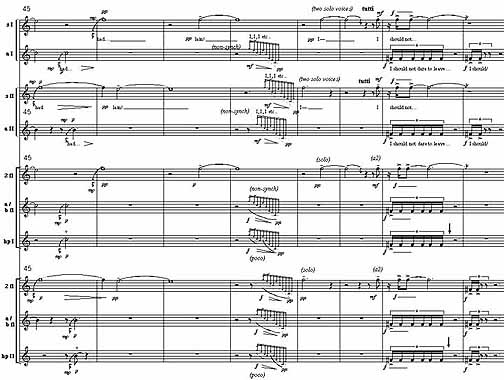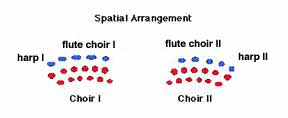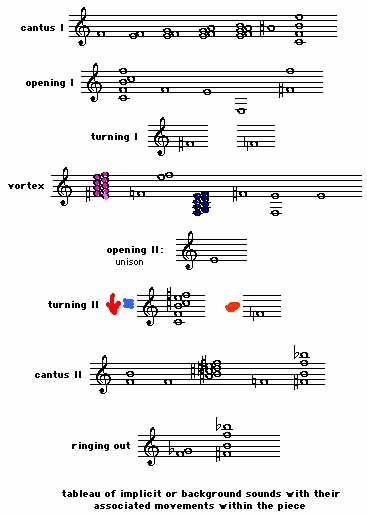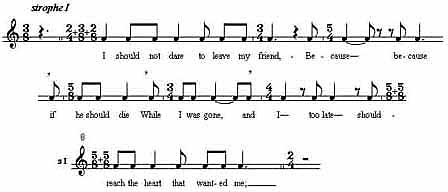"I
should not dare to leave my
friend"
for Double Choirs of 24 female voices, 8 flutes (2 c; alto; bass) and
2 harps based on a poem by Emily Dickinson

(a fragment from the middle of the piece
(page 7))
| pages 1 | 2
| 3 | 4 |
5 | 6 |
7 | 8 |
9 | 10 |
11 | 12 |
13 | 14 |
15 | 16 |
17 | 18 |
19 |
| listen to a
simple computer
model of I should not dare... [requires QuickTime]
| NEW: download PDF of
I should not dare . . .
(twenty-one 11' by 17" (A3) pages) [requires Acrobat
Reader ]
Music in Space
One of the primary features of "I should not dare to leave my
friend"...,
like its companion
pieces
Lament and Everything is...
(also for double choirs
and based on a poems by Rilke and Anna Akhmatova respectively), is the
arrangement
of the ensemble. The 24 voices are grouped together in two complementary
choirs,
each with six sopranos and six altos. The piece may be performed with or
without a
kind of background group of 2 flute choirs (2 x C; alto; bass) and two
harps. The
supporting choirs—which in turn may also be performed independently
of the voices—
play almost entirely sotto voce, which here should be taken literally
as meaning 'playing
under the voices', which creates a unique kind of composite sound or
texture.
One should imagine both of the pieces being sung in a large, resonant space:

Depending on the size and acoustics of the performance space, the flute choirs
and
harps might need to be placed in front of the singers, as well as amplified
slightly.
The dynamics of the piece are restrained throughout—always centered
around mp.
The timbre is, in contrast to the two sister pieces, Lament and
Everything is...,
generally sparse and intimate in character, with the basic trajectory of
the collective
sound being, with a few exceptions, directed inward. As an alternative to
the two flute
choirs, either as an experiment or as necessity dictates, four C trumpets
and four
B-flat trumpets may be used. (Write for the alternative muting
scenario.)
In principle, there is nothing new in this spatial approach. Some of the
compositions
within the Western classical music literature which come first to mind are,
for example,
the vocal works of Hildegard von Bingen and, more especially, the
choral music of
J.S. Bach. Consider, for example, the magnificent opening of the Bach's
Motet for
double choir, Komm, Jesu, Komm (Come,
Jesus, Come: c. 1727).
Sense, Sound and Space
I've sketched below a rough map of what I think of as the background sound
for the whole of the piece. One might think of this as one composite sound
which
is made up of many similar, but much smaller and simpler sounds. One way
to
experience what I have in mind here is simply to have a choir sing all of
the notes
all at the same time, but very softly. Then, from this almost inaudible
background,
one would indicate for groups of voices to gradually get louder, thereby
emerging into the foreground, and then while getting softer, fold back into
the
larger, more general sound again. If one were to walk slowly through the
timbral map given below in this way, one would instantly have a sense of
how
the sound character of the music changes from moment to moment in the piece.
This little experiment would bring out three points of some significance:
(1) The character of sound, directly analogous to any kind of adjective that
comes to
mind, like sharp, or thin, or brittle, or warm, or harsh—is normally
my primary
point of departure. I don't generally think in terms of intervals, although
I
try use them with great care to obtain the quality of sound I want.
(2) The map below is just a map, that is, a highly abstract set of symbols.
The
danger of such representations is that, once we have them, the mind tends
to 'run
off' with them, as it were, and use or apply them in areas that are not
appropriate.
(Think of, for example, the maps of intelligence based on how a computer
program at present works when applied mecahnically to the mind.) What I do
in my
work is begin with the actual sound—which in my view cannot be
explained,
that is, how one actually does this; it can only be demonstrated— and
then
proceed to the mapping stage, or in the case of a performance score, the
actual
musical notation. (My central criterion as to how the music is finally
written down is essentially a negative one: avoid all unnecessary difficulty.
This tends towards a natural kind of simplicity even though the music
may still be at first difficult to perform, but then, hopefully, only because
it
is new.)
(3) Despite the limitations of the map analogy, it is still a pretty
good
one when applied to sound. This is because sound in its very most general
sense is indeed spatial, that is, it is characterized by the
co-presence of difference.
I fully realize that this sounds very theoretical if not arcane, but
actually it is not.
This way of thinking about sound is not much different then thinking about
how
you have the different items, say, a bed, a writing table, a chair, distributed
in a
room.They are all together present at the same time, which establishes
instantly
a happy or not so happy interplay of the different elements. The key point
is that time, or rhythm in music, as we experience it, is very different.
Things,
that is, difference, happen as we say—one at a time, and not all together
at once.
One of the wonderful and fascinating things in music is how time and space
in this sense refer or point or imply one another, one folding into the other
and
back again.You can experience something of this even if you do not read music
simply by playing single notes on a piano while pushing down the sustaining
pedal:
each single step of a line or journey—the separate notes—becomes
part of the
weave of the whole—a (background) chord. This is in my view exactly
what
happens also in a poem. As we hear or read the poem, we push down the
"sustaining pedal" of meaning, and hear as a kind of chord all the
different
sounds and senses resonating together. This then is how the poem and the
music are inherently very closely and intimately related. And also—at
least
this is true in my case—this is how certain qualities of musical sound
may be
felt to manifest or express the sense or quality of a poetic image.
On the map below, you can click on the notated sounds to take you to the
corresponding passage in the performance score:

The Poem
(recording)
"I should not dare to leave my friend"The music follows very closely
the rhythm of the poem, using for this a new kind of composite meter
composed
of different groupings of 2's and 3's. Here's a simplified view of the first
stanza
of the Dickinson poem shown in the type of metrical notation used in the
piece
Note that, despite the tempo changes, the eighth remains constant
throughout,
with the tempo around quarter = 76 (152)):

And here is the complete four stanza text of the poem. (To view the entire
metrical
version of the same text, go to the one-page
version of the basic vocal line.)
I should not dare to leave my friend,
Because—because if he should die
While I was gone, and I—too late—
Should reach the heart that wanted me;
If I should disappoint the eyes
That hunted, hunted so, to see,
And could not bear to shut until
They "noticed" me—they noticed me;
If I should stab the patient faith
So sure I'd come—so sure I'd come
It listening, listening, went to sleep
Telling my tardy name,—
My heart would wish it broke before
Since breaking then, since breaking then,
Were useless as next morning's sun,
Where midnight frosts had lain!
Emily Dickinson
(1) Listen to a recording of Cliff Crego reading
"I
should not dare to leave my friend"
by Emily Dickinson
(2) Other recordings:
Four
Miniatures a quartet of classics by Emily
Dickinson:
Have you got a brook; Much Madness;
Glee—the great Storm is over;
Each Life
(3' 31": 341K)
| pages 1 | 2
| 3 | 4 |
5 | 6 |
7 | 8 |
9 | 10 |
11 | 12 |
13 | 14 |
15 | 16 |
17 | 18 |
19 |
| listen to a
simple computer
model of I should not dare... [requires QuickTime]
| NEW: download PDF of
I should not dare . . .
(twenty-one 11' by 17" (A3) pages) [requires Acrobat
Reader ]
| back to
Picture/Poems:
Central Display | see also the vocal score of
Lament for Double
Choir |
| go to the Cliff Crego's New Music website,
The Circle in the Square:
Central Display |
| go to
Circle/Square:
Download to download
ETFs that you can display and listen to on your own computer |
| Other websites by Cliff Crego:
picture-poems.com  Picture/Poems;
Picture/Poems;
Also: The Poetry
of Rainer Maria Rilke | Dutch poetry
r2c
Created and maintained in Northwest Ohio, USA.
(I.14.2000; updated
IX.3.2001)
Questions regarding performance
materials to
score-info@cs-music.com;
Copyright © 1999-2001 Cliff Crego All Rights
Reserved



